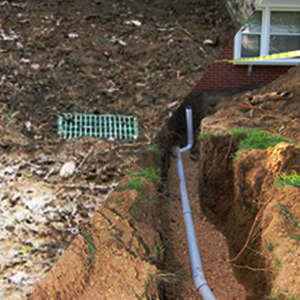French Drains or Surface Drains?

With the extreme rainfall in DFW over the last 4 months of 2018, many homes have been identified as having inadequate drainage. If a home has proper drainage, there is never any areas within 4 feet of a foundation where water stands after heavy rains. Poor drainage (or ponding) around a home can cause the soils to swell which in turn causes a foundation to heave (move upward) excessively. That movement is typically associated with brick and sheetrock cracks, doors to not work properly, and can even cause plumbing pipes to separate. Poor drainage is addressed by installing either Surface Drains or French Drains or both. How do you know which to use?
Many homeowners think all drains are “French Drains”. However, a French Drain is a very specific type of drain designed, generally, to capture and re-route groundwater (water traveling beneath the surface). Groundwater going underneath a foundation can cause the foundation to heave.
Installing a French Drain entails digging a trench (36” to 48” or more) between the uphill source of the groundwater and the foundation. The trench has to be deep enough to be able to capture the water before it goes underneath the foundation. A moisture barrier (typically a thick plastic sheet) is installed on the foundation side of the trench. A perforated pipe with some type of porous cloth around it is placed at the bottom of the trench. The trench is then backfilled with gravel. Water traveling underground encounters the gravel and falls to the bottom of the trench and enters the pipe through the perforations. The pipe is sloped underground to direct the collected water towards an area on the surface that is lower than the pipe (discharging via gravity). If it is not possible to gravity drain, the water can be collected in a sump and pumped out as needed.
A Surface Drain is designed to capture and transport water ponding on the surface. Catch basins (or collection boxes) are installed in low areas allowing water to enter through the grate on the top of the catch basin (visualize a grated inlet in a parking lot, just on a smaller scale). The catch basins are connected to a solid pipe that directs the water to an area where it will disperse. If it is not possible to gravity drain, a sump/pump can be installed to collect and pump the water away.
DFW residents with questions about the need for either a French Drain or Surface Drain can be answered by Structured Foundation Repairs. Contact us today at 972-484-1200 for a free evaluation!
